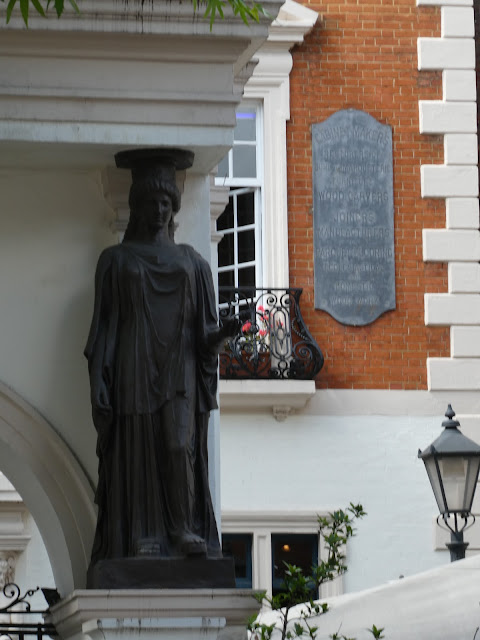Most people would probably associate the King's Road with shopping in the Sixties, but of course it has a much more interesting history than that. It was, as the name suggests, originally the King's Road, a private road for the king (King Charles II) to enable him to pass quickly through London and out into the countryside at a time when decent roads were few and far between.
It certainly doesn't lack for shops (or pubs, restaurants or traffic). But there is a fair amount else, especially if you pop down the odd side street. And a real mish mash of architectural styles.
So this, in case you were in any doubt, is a Moravian burial ground and chapel. It was founded in 1751. And one of the beliefs of this little sect is that everyone must be equal in death, so no elaborate gravestones, just all these equal sized slabs in the ground. It is quite a contrast from the hustle and bustle only a few meters away.
At the bottom of the graveyard is a long bench with the history of Beaufort House, the former mansion of Sir Thomas More which used to be here, written along the back of it.
Back on the King's Road here is a restaurant, the Bluebird, in an art deco garage. Couldn't get a decent photo from across the road with the passing traffic and buses.
Just off the King's Road are a number of elegant squares laid out in the early 19th century. This one is Paultons Square. They all have well kept although generally small gardens in the middle. And all of them are private, which is probably how they look so well manicured. I was sticking my camera through the railings....
This is the Old Rectory, which dates from the late 18th century. It is well hidden from prying eyes by high walls and solid gates, perhaps unsurprisingly as the owners have 2.5 acres of private gardens behind it all.
Here is another super quirky building - originally a dairy stood here hence the cow's head and tiles. It was a recording studio in the swinging sixties.
And here, as it proudly states, are the Turner Studios where JMW Turner painted
Going down this side street (Glebe Place) you then get some Arts & Crafts houses
Culminating in this vegetation covered Mediterranean baroque pile.
And then there is this modest little house designed by one of the biggest names in design, Charles Rennie Mackintosh.
This is Dovehouse Green, a small park on what was once the local workhouse
Beyond the Green is St Luke's Church which demands attention on size grounds alone. Apparently it was one of the first neo-Gothic churches to be built in England (followed by a vast number of others) and can seat 2500 in its nave, although I guess nowadays it would be delighted to get 250 through the door.
This is one half of Old Chelsea Town Hall. Rather unusually it has two grand entrances at either end, this is just the right side one, but little striking in the middle. Impossible to get a shot of the whole lot with the passing traffic.
A splendid arts & crafts shop.
Another place one can't photograph in a way to do it justice is the very grand the Pheasantry, built in 1769, but now suffering the indignity of serving as a Pizza Express.
And more fine squares....
The colourful Bywater Street.
This is Wellington Square, where it is believed James Bond lived (if had been a real living person)
This is Royal Avenue, actually laid out by Sir Christopher Wren as this should have been a grand avenue between the Royal Hospital and Kensington Palace. The project was abandoned with the death of Charles II.
And beyond this open recreation ground is the very grand entrance to the Saatchi Gallery, formerly the headquarters of the Duke of York. I was last here to see the Tutankhamen exhibition the day before the first Lockdown started...










































































No comments:
Post a Comment